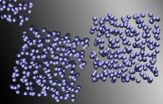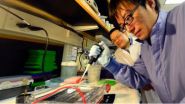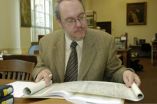(Press-News.org) NEW YORK – (March 24, 2014) – Scientists from Weill Cornell Medical College and Houston Methodist have found that a gene previously unassociated with breast cancer plays a pivotal role in the growth and progression of the triple negative form of the disease, a particularly deadly strain that often has few treatment options. Their research, published in this week's Nature, suggests that targeting the gene may be a new approach to treating the disease.
About 42,000 new cases of triple negative breast cancer (TNBC) are diagnosed in the United States each year, about 20 percent of all breast cancer diagnoses. Patients typically relapse within one to three years of being treated.
Senior author Dr. Laurie H. Glimcher, the Stephen and Suzanne Weiss Dean of Weill Cornell Medical College, wanted to know whether the gene – already understood from her prior work to be a critical regulator of immune and metabolic functions – was important to cancer's ability to adapt and thrive in the oxygen- and nutrient-deprived environments inside of tumors. Using cells taken from patients' tumors and transplanted into mice, Dr. Glimcher's team found that the gene, XBP1, is especially active in triple negative breast cancer, particularly in the progression of malignant cells and their resurgence after treatment.
"Patients with the triple negative form of breast cancer are those who most desperately need new approaches to treat their disease," said Dr. Glimcher, who is also a professor of medicine at Weill Cornell. "This pathway was activated in about two-thirds of patients with this type of breast cancer. Now that we better understand how this gene helps tumors proliferate and then return after a patient's initial treatment, we believe we can develop more effective therapies to shrink their growth and delay relapse."
The group, which included investigators from nine institutions, examined several types of breast cancer cell lines. They found that XBP1 was particularly active in basal-like breast cancer cells cultivated in the lab and in triple negative breast cancer cells from patients. When they suppressed the activity of the gene in laboratory cell cultures and animal models, however, the researchers were able to dramatically reduce the size of tumors and the likelihood of relapse, especially when these approaches were used in conjunction with the chemotherapy drugs doxorubicin or paclitexel. The finding suggests that XBP1 controls behaviors associated with tumor-initiating cells that have been implicated as the originators of tumors in a number of cancers, including that of the breast, supporting the hypothesis that combination therapy could be an effective treatment for triple negative breast cancer.
The scientists also found that interactions between XBP1 and another transcriptional regulator, HIF1-alpha, spurs the cancer-driving proteins. Silencing XBP1 in the TNBC cell lines reduced the tumor cells' growth and other behaviors typical of metastasis.
"This starts to demonstrate how cancer cells co-opt the endoplasmic reticulum stress response pathway to allow tumors to grow and survive when they are deprived of nutrients and oxygen," said lead author Dr. Xi Chen, a postdoctoral associate at Weill Cornell, referring to the process by which healthy cells maintain their function. "It shows the interaction between two critical pathways to make the cells better able to deal with a hostile microenvironment, and in that way offers new strategies to target triple negative breast cancer."
Scientists still need to study how those strategies would help women with the disease.
"Obviously we need to know now whether what our group saw in models is what we'll see in patients," said coauthor Dr. Jenny Chang, professor of medicine at Weill Cornell and director of the Houston Methodist Cancer Center. "We are very excited about the prospect of moving this research forward as soon as possible for the benefit of patients."
INFORMATION:
The study was funded by the National Institutes of Health (CA112663 and AI32412) and the Leukemia and Lymphoma Society.
Also contributing to the Nature report were Junhua Mai, Haifa Shen, Melissa D. Landis, and Mauro Ferrari (Houston Methodist Hospital), Minkyung Song, Chen Tan, Stanley Adoro, and Sandra J. Shin (Weill Cornell Medical College), Dimitrios Iliopoulos and Maria Hatziapostolou (University of California, Los Angeles), Qing Zhang (University of North Carolina at Chapel Hill), Qianzi Tang (Tongji University and Sichuan Agricultural University, China), Matthew B. Greenblatt (Brigham and Women's Hospital), Elgene Lim, Min Ni, Yiwen Chen, X. Shirley Liu, and Myles Brown (Dana-Farber Cancer Institute and Harvard Medical School), Wai Leong Tam (Whitehead Institute for Biomedical Research), Dorothy Z. Hu (Massachusetts General Hospital), Bella Hu (Children's Hospital Boston).
Weill Cornell Medical College
Weill Cornell Medical College, Cornell University's medical school located in New York City, is committed to excellence in research, teaching, patient care and the advancement of the art and science of medicine, locally, nationally and globally. Physicians and scientists of Weill Cornell Medical College are engaged in cutting-edge research from bench to bedside, aimed at unlocking mysteries of the human body in health and sickness and toward developing new treatments and prevention strategies. In its commitment to global health and education, Weill Cornell has a strong presence in places such as Qatar, Tanzania, Haiti, Brazil, Austria and Turkey. Through the historic Weill Cornell Medical College in Qatar, the Medical College is the first in the U.S. to offer its M.D. degree overseas. Weill Cornell is the birthplace of many medical advances — including the development of the Pap test for cervical cancer, the synthesis of penicillin, the first successful embryo-biopsy pregnancy and birth in the U.S., the first clinical trial of gene therapy for Parkinson's disease, and most recently, the world's first successful use of deep brain stimulation to treat a minimally conscious brain-injured patient. Weill Cornell Medical College is affiliated with NewYork-Presbyterian Hospital, where its faculty provides comprehensive patient care at NewYork-Presbyterian Hospital/Weill Cornell Medical Center. The Medical College is also affiliated with Houston Methodist. For more information, visit weill.cornell.edu.
Houston Methodist
Houston Methodist is a private non-profit health care organization comprised of a major academic medical center, six community hospitals, emergency centers, physical therapy clinics, a research institute, and a comprehensive residency program. Our flagship, Houston Methodist Hospital, was home to heart surgery pioneer Michael E. DeBakey, M.D., and has been the site of numerous medical breakthroughs, such as the world's first multiple-organ transplant in the 1960s, gene therapy for prostate cancer, and the first islet cell transplants in Texas. A legacy of medical milestones has attracted patients from around the world to Houston Methodist for more than 90 years. Houston Methodist is consistently ranked among the country's top hospitals by U.S. News and World Report. In 2013, Houston Methodist was named the top hospital in Texas and one of the country's top hospitals in 12 specialties. Houston Methodist has also been named to Fortune magazine's annual list of "100 Best Companies to Work For" for eight straight years.
Gene implicated in progression and relapse of deadly breast cancer finding points to potential Achilles' heel in triple negative breast cancer
2014-03-24
ELSE PRESS RELEASES FROM THIS DATE:
Like being inside a star
2014-03-24
Some experiments are really difficult to perform in practice. To gain a detailed understanding of the behaviour of molecular hydrogen (H2), for example, we would have to produce such high pressures as those occurring within the core of gaseous planets like Jupiter and Saturn or inside stars. If such conditions cannot be created, an alternative method is to simulate them on the computer, but the model has to be accurate. A group of research scientists from the International School for Advanced Studies (SISSA) in Trieste used a simulation model that is far more accurate than ...
Pioneering research offers new insight into improved wave energy testing
2014-03-24
Pioneering research could provide a significant boost in the vital quest to harness wave power as a viable renewable energy source for the future.
Scientists from the University of Exeter have studied how wave energy developers can more accurately measure, and predict the wave conditions within wave energy test sites.
The research, which is published in leading scientific journal Energy, deployed wave measurement buoys and used wave modelling to show how variations in wave size and strength could be resolved.
The results should aid developers to better predict sea ...
Maturitas publishes position statement on management of vertebral osteoporotic fracture
2014-03-24
Amsterdam, March 24, 2014 – Elsevier, a world-leading provider of scientific, technical and medical information products and services, today announced the publication of a position statement by the European Menopause and Andropause Society (EMAS) in the journal Maturitas on the topic of the management of postmenopausal women with vertebral osteoporotic fracture.
Vertebral osteoporotic fracture is an underestimated condition as only about a third of people with the disease seek medical attention. While it may cause acute back pain, the presentation may be insidious with ...
Protein called YAP gives blood vessels strength, shape
2014-03-24
AUGUSTA, Ga. - A protein known to promote cancer appears to give the blood vessels strength and shape, researchers report.
When yes-associated protein, or YAP, is deleted from vascular smooth muscle cells during development, the protein makes thin-walled blood vessels that over-dilate in response to the usual pressure of blood flow, said Dr. Jiliang Zhou, vascular biologist at the Medical College of Georgia at Georgia Regents University.
"The thickness of the arterial wall decreases from three or four layers of smooth muscle cells to one or two layers," said Zhou, corresponding ...
From mouse ears to man's?
2014-03-24
One in a thousand children in the United States is deaf, and one in three adults will experience significant hearing loss after the age of 65. Whether the result of genetic or environmental factors, hearing loss costs billions of dollars in healthcare expenses every year, making the search for a cure critical.
Now a team of researchers led by Karen B. Avraham of the Department of Human Molecular Genetics and Biochemistry at Tel Aviv University's Sackler Faculty of Medicine and Yehoash Raphael of the Department of Otolaryngology–Head and Neck Surgery at University of ...
Guarding grapes and other tales from papyri
2014-03-24
If you weren't careful, you might end up beaten by grape thieves skulking in the darkness.
A University of Cincinnati graduate student writes about the contractual obligations of vineyard guards and researchers from around the world contribute more stories from ancient times in the most recent volumes of the Bulletin of the American Society of Papyrologists (BASP).
UC's Peter van Minnen, associate professor of classics, has edited the international journal since 2006. BASP is an annual collection of articles and reviews pertaining to important discoveries from around ...
Lots of carbon dioxide equivalents from aquatic environments
2014-03-24
Large amounts of carbon dioxide equivalents taken up by plants on land are returned to the atmosphere from aquatic environments. This is the conclusions from a study carried out by two students at Linköping University, Sweden.
As students at the Master program Science for Sustainable Development in Linköping, Bala Panneer Selvam and Sivakiruthika Natchimuthu, did a thorough investigation of greenhouse gas emissions from many types of inland waters in India under supervision by Dr Lakshmanan Arunachalam, Tamil Nadu Agricultural University, India, and Dr David Bastviken, ...
A towel less: How psychologists harness sociability to cut waste
2014-03-24
Hotel guests can be gently persuaded to reduce the number of towels they use each day, psychology researchers at the University of Luxembourg have found. With fewer towels to wash, this reduces the waste of water, energy and detergent. This is good news for the environment and it cuts costs, so enabling hotels to reduce prices.
Two hotels in Swiss and Austrian ski resorts helped with an experiment in early 2013. Three different signs were placed separately in different bathrooms, all of which gently reminded guests of the environmental impact of towel use. However, one ...
Microfluidic device with artificial arteries measures drugs' influence on blood clotting
2014-03-24
A new microfluidic method for evaluating drugs commonly used for preventing heart attacks has found that while aspirin can prevent dangerous blood clots in some at-risk patients, it may not be effective in all patients with narrowed arteries. The study, which involved 14 human subjects, used a device that simulated blood flowing through narrowed coronary arteries to assess effects of anti-clotting drugs.
The study is the first to examine how aspirin and another heart attack prevention drug respond to a variety of mechanical blood flow forces in healthy and diseased arteries. ...
Would you believe your hand could turn into marble?
2014-03-24
This news release is available in German.
The study was published in the international scientific journal PLOS ONE on 13 March 2014.
To induce an illusory perception of the material properties of the hand, a group of neuroscientists from Bielefeld University, the Max-Planck Institute for Biological Cybernetics (Germany), and the University of Milano-Bicocca (Italy) asked volunteers to sit with their hands lying on a table in front of them. They repeatedly hit the participants' right hands gently with a small hammer while replacing the natural sound of the hammer ...




